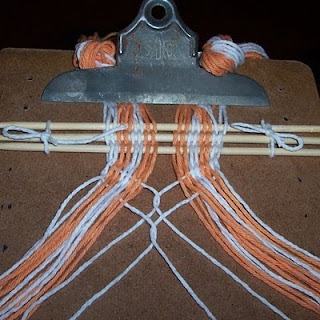Fingerweaving Tutorial – Flat Weave: Diagonal/Candy Cane Stripe
Weaving without a loom
By Franco Rios
Weavers language:
Warp: threads that are vertical
Weft: threads that are woven horizontally in and out of the warps
Shed: the space between upper and lower warps where weft goes through

The yarn is Peaches & Creme and Sugar N Cream cotton yarn, 4 ply worsted, thickness is 12 wraps per inch (WPI). It's not expensive in USA. You can use acrylic yarn or acrylic/wool blend if you have it. You need about 16 to 18 feet of it.

I wrapped each color 8 times around the clipboard which is about 12 inch long.

I cut the yarn so I have 8 pieces of each color, about 24 inch long. Then I arranged the yarn together so I have a 24 inch long bunch of yarn with 16 pieces total.

I arranged the threads into groups of red and white. I clamped the middle of the bunch, letting one half hang down the front of the clipboard and the other half hangs down the back. You can put a loose knot in the half you are not weaving to help keep threads from sliding.
Taking the first yarn on the right, I start the first row by weaving it through the yarns hanging down the front. I make sure I go over the second yarn on the right, under the third, over the fourth and so on until I come out the other side.

I start the second row by taking the next yarn on the right, which has now become the first yarn, over the second yarn, under the third and so on. Notice how the white yarn from the first row goes under the yarn from the second row.

I start the third row by taking the next yarn, I go over the second yarn, under the third, over the fourth and so on. Notice how the yarn from the second row now goes under the yarn from the third row.
To help you see how the yarn is woven, I've left it very loose in the pictures above. Normally you would tighten up the weave so it is narrower and the rows are closer together. Notice how the color is migrating from one side to the other.

By raising the upper and lower threads, I can show you the area called the "shed" where the "weft" goes. The weft is the yarn that goes across the "warp." The warp is the name for the vertical yarns.

I use two hands to manipulate the yarns over and under to make the shed for the weft to go through. My left hand holds the bunch of yarn on the left as my right hand picks the upper and lower yarns to weave through. Notice how the warp is kind of bunched together and it covers/hides the weft going through it. This is called warp faced weaving since the warp is what shows on the face of the cloth. After picking the upper and lower threads, I pull the weft thread through the shed.

Here is the weft pulled through the warps. The thread on the right is going to be the next weft to be pulled through. The thread on the left is the weft going across the warps and will become a warp on the next row.

When I got close to the end, with about 4 or 5 inches to go, I have to decide how to finish this braid. When I had two red yarns left on the right, I tied the last two yarns on the left with a loose knot to hold them in place. Then I took the two red yarns on the right and the two white yarns on the right to make a four strand braid to be tied off with an overhand knot. Then the next four yarns are white. Then two white and two red make a braid. Leaving the last four red yarns to make a braid. The four strand braid is often called “chicken track” because of the vee shaped pattern.
The other half of the flat weave is hanging on the back side of the clipboard. So I turn the flatweave around, with the same side up, I don't flip it. The starting thread must on the right and the exit point is on the left. Now the unwoven yarns are hanging down the front of the clipboard. I start weaving again to the other end. If you put a loose knot in the other half, now is the time to remove the knot so you can weave that half.

Here is the finished flat weave, braided on both ends. You might use this sample as a handle for a bag or sewn as decorative feature on another item. Once you understand the basics you can create longer and wider pieces.
Have a good day!
Franco Rios
If you have any questions, please join us on the FingerWeaving yahoogroup
http://groups.yahoo.com/group/FingerWeaving/
Be sure to check the list of Links (click the word Links at group home page)
to view other websites with information
For another diagram showing the weaving method goto
Carol James Sashweaver.ca website, see the four pictures in middle of page,
click pic on the right side for a diagram of finger weaving
http://www.sashweaver.ca/resources-book.html
This tutorial is also available for download as PDF
http://www.rabbitgeek.com/file/diagonalstripetutorial.pdf
 (click picture for larger view)
(click picture for larger view)



























